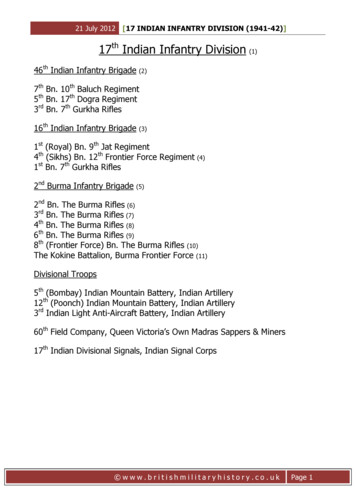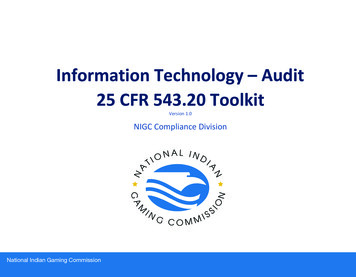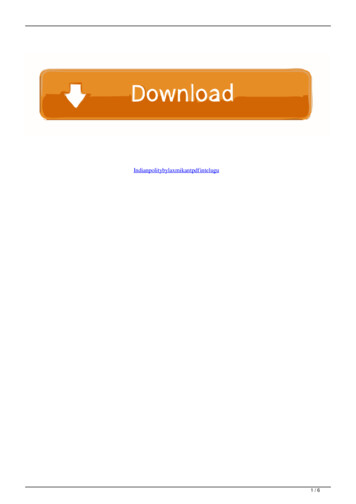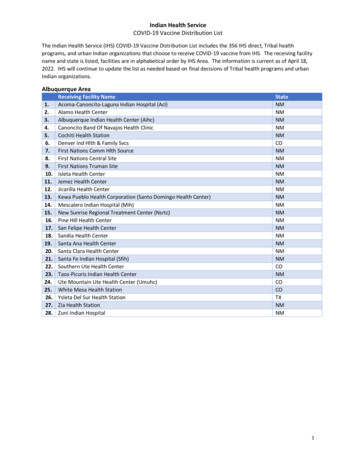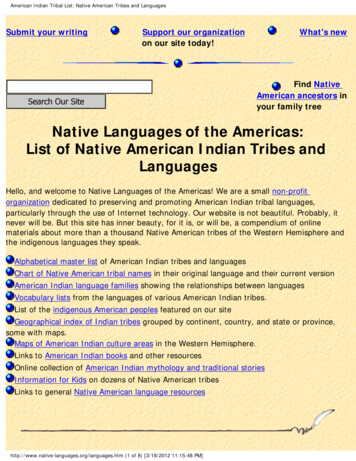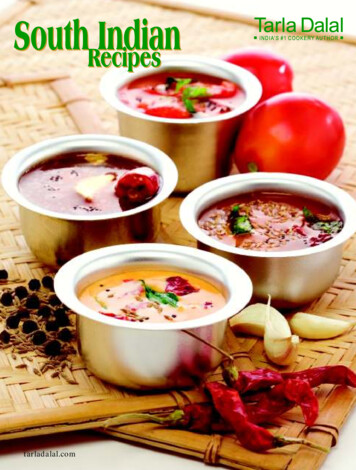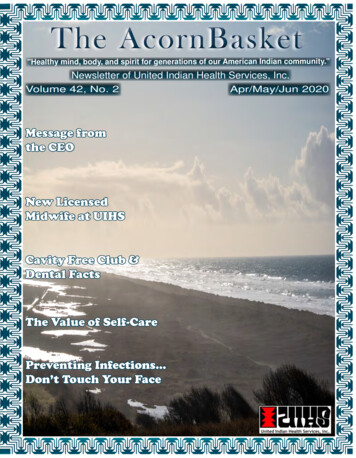
Transcription
The AcornBasket"Healthy mind, body, and spirit for generations of our American Indian community."Newsletter of United Indian Health Services, Inc.Volume 42, No. 2Message fromthe CEONew LicensedMidwife at UIHSCavity Free Club &Dental FactsThe Value of Self-CarePreventing Infections Don’t Touch Your FaceApr/May/Jun 2020
1
Inside this IssueMessage from the CEO . Page 03Fresh Basil Pesto. Page 04Preventing Infections Don’t Touch Your Face . Page 06New Hires / Looking for a Job? . Page 07Cavity Free Club & Dental Facts . Page 08Hypertension: It Doesn’t Hurt, So What’s the Big Deal? . Page 09A New Classification of Illness. Page 12Spring Heralds Ceremony Season . Page 12The Importance of a No’os . Page 14Mindful Moment . Page 16The Value of Self-Care: Putting it into Practice. Page 17New Licensed Midwife at UIHS . Page 19Know your Resources . Page 21Game Page . Page 222
Message from the CEOSubmitted by: John R Reeves III, CEO, UIHSWhat an exciting time for UIHS By the time this reaches you all, I am hoping to have hadthe opportunity to speak with a few of you during ourAnnual Membership Meeting which occurred on February22, 2020. If you did not have the chance to attend, I wouldask you plan to next year. As this is a great way to getfamiliar with the many services our organization provides,as well to gain valuable information about your care. Wealso may have some awesome give-a-ways, and evenfood. I can’t wait to see everyone again next year!United Indian Health Services Turns 50 – As many ofyou are likely aware, UIHS was born in 1970, making 2020its fiftieth year! We have some exciting things planned tocelebrate this organizational milestone, so keep an eyeon the various platforms we utilize in disseminating ourinformation. We are excited to share our history together!Improved Access – As an organization, in the past few months we have focused on improving ourclient access (your ability to get an appointment), it appears from the data we look at monthly, thatwe are succeeding! In the past five months, UIHS has set the record for most clients seen in a givenmonth, not once but twice! In January of 2020, UIHS registered 6,482 client visits! January brokethe previous record, which was set in October of 2019, when we saw 6,408 client visits. Improvedaccess will continue to be the goal, as we continue to staff up our clinical service lines over theremainder of the year.Client Comments and Concerns – I would like to thank each and every one of you for theexpression of your comments, as well as your concerns. As we continue to improve our process inhandling complaints and comments in an efficient and effective manner, I would like to ask you tocontinue to bring these forward. We would like to express to our clients that we have an establishedprocess in which to register, route, address, and then close out each comment or concern we receive.It is important that we continue to hear from you as clients about the areas in which we can improveour care as an organization.Dental Provider Staffing – I am pleased to announce that in February, we added two new dentalproviders to our team, one at our Smith River site, and another at our Potawot Health Village site.This is exciting, because 2019 we experienced a bit of turnover in dental, which impacted our dentalappointment access. Expect things to drastically improve both in Del Norte, and Humboldt as far asappointment availability is concerned!As I leave you this time, I will take the opportunity to thank each and every one of you for your faith inour ability to provide care! I will again mention that we exist because of you. At the end of the day,we realize that you have the opportunity to seek care anywhere in Humboldt and Del Norte counties,and we are pleased you come in to see us in your time of need.Until next time 3
4
5
Preventing Infections Don’t Touch Your FaceSubmitted by: Michelle Lewis-Lusso, Infection Prevention/Employee Health, UIHSTo help prevent infections, keep your hands awayfrom your eyes, nose, and mouth. Why? Touching themucous membranes on your face with your dirty handsallows germs that cause respiratory infections to enterthe body.WHY IS NOT TOUCHING YOUR FACE SOIMPORTANT?It is estimated that people touch their faces about 23times per hour! Respiratory infections can be causedby many different bacteria, viruses, and other diseasecausing germs. When you touch your face with dirty,unwashed hands, germs can take up residence in yourmucous membranes which can lead to an infection.HOW ARE RESPIRATORY INFECTIONS SPREAD?Respiratory infections, like pneumonia or the flu, can spreadthrough droplets in the air when a sick person coughs, sneezes,or talks near you. Respiratory infections can also spread by directcontact with bacteria, viruses, and other disease-causing germs.When we touch people who are sick, or touch dirty surfaces, wecontaminate our hands with germs. We can then infect ourselveswith those germs by touching our face.HOW CAN I PROTECT MYSELF FROM RESPIRATORY INFECTIONS?There are several ways that you can protect yourself from getting a respiratory infection: Avoid touching your eyes, nose, and mouth. Never touch your face with dirty hands. Wash your hands frequently. Washing hands with soap and water is the best way to get rid ofgerms in most situations. Use an alcohol-based hand sanitizer to clean your hands if soap and water are not available. Get a flu shot every year. Encourage your family and friends to get a flu shot too! Ask your healthcare provider if the pneumonia vaccine is right for you. Avoid being close to people who are coughing and sneezing.6
New HiresLooking for a Job?Submitted by: Marina Straughan,Human Resources- Recruiter, UIHSUIHS is a full service healthcare facility.We continue to fulfill our mission by usingteamwork and providing integrated healthcare.Our divisions include: Medical, Dental, Vision,Pharmacy, Behavioral Health, and CommunityHealth and Wellness. At UIHS we offer ourstaff excellent benefits, a healthy work life balance, and competitive wages. Come check outour beautiful location for yourself. We welcome the public to come enjoy our Farmers Markets,walking trails and more. While at Potawot Health Village, come by our Administrative officeto learn about our current job opportunities! If you’d prefer digital, check out our websiteunitedindianhealthservices.org/. There you will find more information about the organization,as well as a list of all job openings.If you are interested in learning more about our jobs and would like to talk to someone directly,please reach out to Marina Straughan at (707) 825-5000 or email: Marina.Straughan@uihs.org.7We look forward to hearing from you!
Call to Make an AppointmentPotawot Health Village at (707) 825-5040Crescent City Clinic at (707) 464-2583Cavity-Free ClubSubmitted by: Meghan McCullough, Registered Dental Hygienist, UIHSKarter QuinnSophia BrownMariah Cota-LoveallCheygoone GensawBlake GrahamMikah SheafChris WennerholmAlex WennerholmWeysenaw ReedAlena BrownCaroline ChristianRebecca ChristianMadisyn Ogua MccoveyRosalee BurgerGracelyn CoxJaron PowellAbigail HunterFaith SmithAustin Atmore6 Yrs Old8 Yrs Old3 Yrs Old9 Yrs Old5 Yrs Old2 Yrs Old9 Yrs Old7 Yrs Old11 Yrs Old9 Yrs Old7 Yrs Old10 Yrs Old6 Yrs Old15 M Old5 Yrs Old13 Yrs Old4 Yrs Old9 Yrs Old9 Yrs OldCassius CalderonMason HedrickFreedom JenkinsRobert MoscaraDrake WardKylie FowlerFranklin FowlerAnsley BartooAvery BartooArdie EleckKaylani KellyKylee VanceKymber VegnaniMalania MoultonNevaeh Abbott BrownTucker SandersonDean ColegroveAndee Lewis1 Yr Old9 Yrs Old6 Yrs Old5 Yrs Old9 Yrs Old7 Yrs Old5 Yrs Old8 Yrs Old8 Yrs Old13 Yrs Old11 Yrs Old10 Yrs Old13 M Old9 Yrs Old5 Yrs Old3 Yrs Old7 Yrs Old9 Yrs OldIf you want to be a member of the Cavity Free Club, make an appointment with ourreceptionist to see the hygienist to find out what it takes to become a member of thisprestigious club and be cavity free! We look forward to seeing you!! If you are aregistered American Indian client, we have openings available for dental cleanings.Dental Facts & FunSubmitted by: Meghan McCullough, Registered Dental Hygienist, UIHSFun Dental History Facts: Most Americans did not brush their teeth every day until after WW2. In WW2, the militaryrequired soldiers to brush their teeth twice daily and brought that habit home after the war. Archeologists have evidence of the first dental fillings in teeth from people who lived 7,500 and9,000 years ago. Orthodontics was the first recognized specialty in dentistry. The first toothbrushes were tree twigs: chewing on the tips of the twigs spread out the fibers,which then were used to clean the teeth. In 1905, Dental Assistant Irene Newman was trained to clean teeth. She became the firstDental Hygienist.Cavities and Oral Health:Cavities are caused by bacteria named Streptococcus Mutans. In order for these bacteria to breakdown the tooth structure and form a cavity it needs a food source which is sugar and an acidicenvironment. Cavities are considered to be a transmittable disease because the bacteria is introducedto you from someone else through sharing cups, eating utensils, and toothbrushes. To reduce your riskfor dental cavities eat foods that are low in sugar, avoid sticky foods like fruit gummies and dried fruit,avoid drinking soda, drink water, and brush your teeth two times daily with a fluoridated toothpaste andfloss daily. If you would like to have an exam to check for dental cavities, call UIHS Dental services toschedule an appointment with your dental provider.8
Hypertension: It Doesn’t Hurt, So What’s The Big Deal?Submitted by: Terry Raymer, MD, CDC- Diabetes Program Manager & Angel Jensen, Nutritionist-Diabetes Management,UIHSYears ago, when I was periodically donating bloodin Alaska, I kept getting told by the nurse checkingme in that my blood pressure was too high. It wasn’thigh enough to prevent me from donating, but it waswell over “normal.” I didn’t pay too much attentionat first, after all, I did all kinds of aerobic exercise 6days a week, did tai chi, ate pretty well (well sort of),and I had what the books said was a healthy “BodyMass Index.” (Body Mass Index or BMI is a measureof your weight to height ratio; if it is too high it can putyou at risk for certain conditions like hypertension).I just figured I was stressed, or hadn’t slept well, oranything other than I might have high blood pressure.But it kept happening, and I knew from all my workin medicine, especially working in the diabetes field,what that could mean High blood pressure, or hypertension, is a condition where the arteries in our body get less flexibleover time. It can cause damage to the blood vessel walls that can have even more damaging effectswhen people have diabetes and/or high cholesterol. This damage can affect many organs in our bodyand can result in many different disease processes. These include heart attack, stroke, congestiveheart failure, kidney disease, eye disease, and decreased blood flow to our internal organs or ourlower extremities (“peripheral vascular disease”). I also knew that treating high blood pressure is themost important thing we can do besides stopping smoking to decrease our risk for conditions likeheart attack, stroke, and all those listed above.Remembering all this, I decided to see my Nurse Practitioner at the local community clinic. I hadn’thad a check-up in a few years, so I figured what could I lose? She ran few tests, did a basic physical,and she checked my blood pressure. Too high, over 140/90. I was kind of surprised because I triedto be healthy, but I also remembered that my mom has high blood pressure. All my lab tests includingmy cholesterol came back normal, so we gave it another 3 months of trying to cut out salt and getbetter sleep. I checked it at homeand work, and it was usually overa safe target range. And it was stillelevated when I went back to see myNurse Practitioner, so she put me ona blood pressure medication I oftenuse with my diabetes patients and itcame right down into the target range.That was over 10 years ago and Istill take that medication (at a littlehigher dose) and when I go to donateblood now, my blood pressure isalways in a safe range. I still try toeat healthier, get enough sleep,9
Hypertension: It Doesn’t Hurt, So What’s The Big Deal?Submitted by: Terry Raymer, MD, CDC- Diabetes Program Manager & Angel Jensen, Nutritionist-Diabetes Management,UIHSand stay physically active, but I also take my blood pressuremedication every day. I feel very fortunate, because a lot offolks, especially working age men, don’t go to their medicalproviders a lot (unless they are really sick!) and their first visitto the ER might be for a heart attack or stroke.The UIHS Diabetes Program is partnering with the MedicalDepartment to promote a program to improve our bloodpressure management here at UIHS. There are many thingswe can do to help manage our high blood pressure, or evenprevent it, by the way we eat and how active we are, butsometimes medications are needed, just like in my case.What do the numbers mean?It is always important to know your blood pressure number. It is expressed in two numbers. Forexample, we may say “your blood pressure is 120 over 80.” The higher or “top” number is whenthe heart is in full “pump” mode and the lower or “bottom” number is when the heart is relaxed. Noteveryone has the same goal for their blood pressure, so please talk to your provider or anyone in theDiabetes Program about what your blood pressure is, what your goal should be, and what you can doto improve it. Together, we can partner with you to help eliminate heart and vascular (blood vessel)Why is high blood pressure referred to as the“silent killer”?10
Hypertension: It Doesn’t Hurt, So What’s The Big Deal?Submitted by: Terry Raymer, MD, CDC- Diabetes Program Manager & Angel Jensen, Nutritionist-Diabetes Management,UIHS11
A New Classification of IllnessSubmitted by: Travis Vale, Health Promotion and Education Technician, UIHSRecently, electronic cigarettes have been given a new classification of illness labeled EVALI (Electronic VapingAssociated Lung Injury). The Food and Drug Administration (FDA), Center for Disease Control (CDC), and statehealth authorities all have identified this illness and have given the warning to the public that E-cigarettes that useboth nicotine juice and THC can have harmful effects to the lungs. One major factor of the lung damage comesfrom Vitamin E Acetate. Current recommendations from the CDC and FDA: E-cigarettes are not an approved quit method from the FDA. E-cigarettes can cause EVALI, both nicotine juice as well as THC pods. While it appears that vitamin E acetate is associated with EVALI, there are many different substances andproduct sources that are being investigated. Refrain from buying these products from informal sources, such as friends, family, or in person or onlinesellers. Youth are more prone to become addicted and lifelong users than adults. Studies are still being conducted on the harmful effects of e-cigarettes, new information will emerge in thefollowing years.If you are interested in more information, please visit the following CDC website c pring Heralds Ceremony SeasonSubmitted by: Andre Cramblit, Cultural Resource Specialist, UIHSSpring is here and ceremony season is just around the corner. Also coming up is our summer camp.We are scheduled to take kids (ages 12-17) out to Patrick’s Point June 29 to July 3 and then againfor younger students (ages 9-11) July 13-17. The outdoor event will allow children to participate ina variety of activities supporting healthy lifestyles, culture and language, as well as keeping themphysically active.People prepare for ceremonies in a range of ways. Some begin prayers before they attend aceremony and some fast for up to 10 days prior to the event. Fasting involves not eating and keepingup your strength with water that has acorn powder or cooked acorns in it. Occasionally people fast aspart of their daily life and some people go into isolation to fast.Regalia is brought out and repaired as needed in preparation for ceremonies. Food is collected to feedthe people that will attend. Camping supplies are taken out of storage and updated as required.Ceremonies that will occur include, the flower dance, the brush dance, the jump dance and dependingon the year the white deerskin dance. Some tribes will occasionally hold a war dance for a variety ofreasons.Ceremony season is a time to come together, to share your prayers, thoughts and hopes for a betterworld. It is a chance to see old friends and meet new people who are working together for a commonspiritual goal. Take this opportunity to bring your family to ceremony and be part of the healingprocess.Just my two dentalia’s worth.12
13
What our Ancestors Can Teach us: The Importance of a No’osSubmitted by: Ashley Villagomes, Maternal Child Health CHR, UIHSWith an immense amount of information at our fingertips on pregnancy and parenting in this day inage, it can leaves us questioning, “What is the right way to raise our children.” First there is no rightway, but getting back to our basic ancestral knowledge of parenting can help ease some of thesefeelings.Our ancestors have so much to teach us, looking to them for knowledge and support can bring healingto ourselves and future generations. Traditional practices and ways of life in tribal communities all overthe world are being researched and recommended in western medicine today; the perfect example ofthis is the use of a no’os, the Yurok word for baby basket.In our region, as far back as we can go, we know that our ancestors carried their babies using a no’os.We also know that in many other cultures they had variations of a baby basket, but what they all hadin common was the purpose to keep the babies close to their mothers at all times. On the surface onemay think carrying your baby in this way was purely out of convenience but it goes much deeper thanthat.Having that constant connection with their mother’s body that the no’os provides is the most soothingand emotionally nurturing experience for a baby other than breastfeeding. Carrying your baby actuallygoes hand in hand with breastfeeding, not only do babies feed on their mother’s milk but they feedoff of the constant bodily contact of being close to their mother. It cultivates an ongoing physical andemotional bond between them, which can help regulate the babies breathing, increasemilk production and prevent postpartum depression, all while evoking a sense ofconfidence for the new mother as she walks the path from maiden to mother.As you wrap your baby tightly and lace them up in your no’os, it gives yourbaby feelings of being secure and safe by mimicking the precious timethey spent in their mother’s womb. This traditional practice calms andrelaxes the baby, offering better sleep for both, them and their mother.Because they are unable to move their arms, the baby’s sense of sightis heightened, they begin to observe and process the world aroundthem with intention while exercising and developing their brains.They believe the children brought up in this way will learn toobserve and to look over situations before reacting. In westernsociety they adopted this tradition our ancestors passed down,which can be known as swaddling and is highly recommend toall new parents.These teachings alone reflect what deep connections ourancestors had about the importance of honoring all facets ofourselves; the physical, emotional, and spiritual, to cultivateoverall wellbeing for all ages. These deep knowing’s arethe foundation that made it possible for us to be heretoday and are carving the way for future generationsto thrive. We honor our ancestors every time we laceour babies in a no’os or swaddle them tightly, it’s as ifthey are holding them tightly soothing and comfortingthem, welcoming them into this lifetime.14
15
Mindful MomentSubmitted by: Megan Warren, Diabetes Awareness Program, UIHS16
The Value of Self-Care: Putting it into PracticeSubmitted by: Brian Sheehan, BSW Student, Health Promotion & Education Intern, UIHSWhat exactly is Self-Care? Why is it important for us? Self-care isall about wellness, OUR wellness. Self-care is about our physical,emotional, and mental health; it is about upholding and nourishingthe state of our well-being. Finding a healthy balance of these keyareas of our lives is a daily challenge for many of us; yet, it is vitalfor our quality of life.Many of us are programmed to stay busy, work hard, pressforward, and take care of the family, let alone our other pressingresponsibilities. Further, some argue that “self-care” is a selfishact, and we “should be” focusing on helping others. However, wemust remember that we can’t give away what we don’t have; wecannot pour from an empty glass! Without intentionally taking careof ourselves, our emotional, physical, and spiritual well being,we will have nothing to truly offer others; worse, we will end upburned out, physically sick, and/or spiritually bankrupt. So no, selfcare is not a selfish act; in fact, it is the kindest offering to otherswe can begin with.Knowing where to start in our self-care practice, (yes it is a practice), can be a challenge. In order touncover and discover what area(s) of our life need attending to, we must first become aware; we mustslow things down and check-in with ourselves. Self-reflection is the key to this door, asking: How amI doing today, physically? Am I getting enough sleep? Am I nourishing myself, eating regular healthymeals? How am I doing emotionally? Am I angry, sad, or lonely? How am I doing spiritually? Have Ibecome a “human doing” vs. a human being?Our first most helpful habit will be the practice of mindfulness; here we can further develop our selfawareness. Consistent mindfulness practice is one of the many self-care practices we can draw uponto improve our well-being. Mindfulness simply begins by taking sacred time to ourselves; here, we canbe alone in a calm space, a place we claim for ourselves. This is a time to connect with “me”, sit withmy thoughts, my attitudes, and my feelings. This is a sacred time to focus on my prayers and/or myintentions for the day. This may be a time to practice the tradition of burning sage and/or root. We mayalso use this time for meditation.Ask yourself, have I fallen into any of the H-A-L-T (Hungry, Angry, Lonely, Tired) patterns? If so,practices like healthy eating, forgiveness, connecting with others, and/or basic sleep will get us backon track faster than we may think. Gently pushing ourselves to do these small routine things can havea profound effect on our sense of well-being.A good self-care practice requires engagement, commitment, and consistency; yet, our selfdetermination is what empowers its success.Here are a few more self-care activities to include in our basket of options:1.) Find a creative outlet that you enjoy; whether through the arts or hobbies, this will have benefitsbeyond providing much-needed stress relief;17
The Value of Self-Care: Putting it into PracticeSubmitted by: Brian Sheehan, BSW Student, Health Promotion & Education Intern, UIHS2.) Get out into the great outdoors (taking a walk). This will help us to unwind and can also provide aneffective way to manage our stress.3.) Practice self-nurturing by providing yourself with “creature comforts” by focusing on soothing eachof the five senses: For vision, you might look at beautiful pictures in a book or magazine; for hearing,you can listen to soothing music; for smell, you can burn a scented candle or burn some sage/root; fortaste, drink herbal tea; and touch, stroke your pet, or cuddle a stuffed animal.The main concept behind many of these ideas is to initiate a shift from within, from more negativeenergy to a more positive one. In fact, a positive feedback loop can be started by simply taking bettercare of ourselves, even in what may appear to be menial ways; these can include going to bed andgetting up at reasonable hours or taking a shower and getting nicely dressed. Nourishing ourselves byeating well will also help begin this positive chain reaction.Most importantly, have fun and enjoy the process of our self-care practices. Investing in ourselvesallows us to better serve others because our well-being is fortified and refreshed. Sustaining ourselves,while finding the balance between our physical, emotional, and spiritual selves will improve the truequality of our lives; further, it will empower us to navigate the many challenges life may present18
New Licensed Midwife at UIHSSubmitted by: Sommer Halligan, Licensed Midwife, UIHSI grew up in a small beach town just south of San Francisco, but my family always spent as muchtime as we could in the woods of Mendocino County. I never really liked city life, and so I relocated toHumboldt in 1996. Over the years, most of my family moved up here as well. I am close with them andwe spend a lot of time together. I am the mother of two children, a son and a daughter. I am an avidfan of traditional music and dance, and attend dance camps each summer. I try to spend time outsideevery day, even if it is just for a few minutes. I enjoy doing “hand work,” mostly quilting, knitting andembroidery. I am curious about basket making and beadwork.I came to UIHS because I believe in our mission and core values, and because I believe UIHSrepresents the most effective model of health care services – attending to the mind, body and spirit ofour community and using the best of modern medicine together with traditional healing modalities. Iwill be working at Potawot, Taa-‘at-dvn, and Weitchpec Health Village sites. I will be seeing patientsfor home visits and in clinic for well woman care, birth control, lactation/breastfeeding, preconceptionplanning, and early pregnancy care.It is important to me to build personal relationships with my clients and I want the people I care forto feel honored and respected. I am passionate about providing health education services, so eachperson feels empowered to make decisions that resonate with their own personal values. I believe thatthe human body is an everyday miracle, and I practice midwifery from this perspective. I do this workbecause I am called to service. It has been a tremendous honor to share the journey of childbirth withthe families of the north coast. Becoming a mother was the most transformative experience of my life;being a mother is my greatest joy.19
If you are experiencing a fever, cough, or troublebreathing. Please CALL before coming to see your provider20
21
22
The Acornbasket 1996 United Indian Health Services, Inc.Chief Executive Officer: John ReevesEditor / Layout: SuWorhrom David BaldyIf you would like the Acornbasket Newsletter mailed to your homeor emailed to you please fill in this form and return to: United IndianHealth Services, Inc., 1600 Weeot Way, Arcata, CA 95521Attention: SuWorhrom David BaldyName:Street or P.O. Box:City:State: ZipEmal:
Crescent City Clinic at (707) 464-2583 Submitted by: Meghan McCullough, Registered Dental Hygienist, UIHS. Submitted by: Meghan McCullough, Registered Dental Hygienist, UIHS Dental Facts & Fun. If you want to be a member of the Cavity Free Club, make an appointment with our



